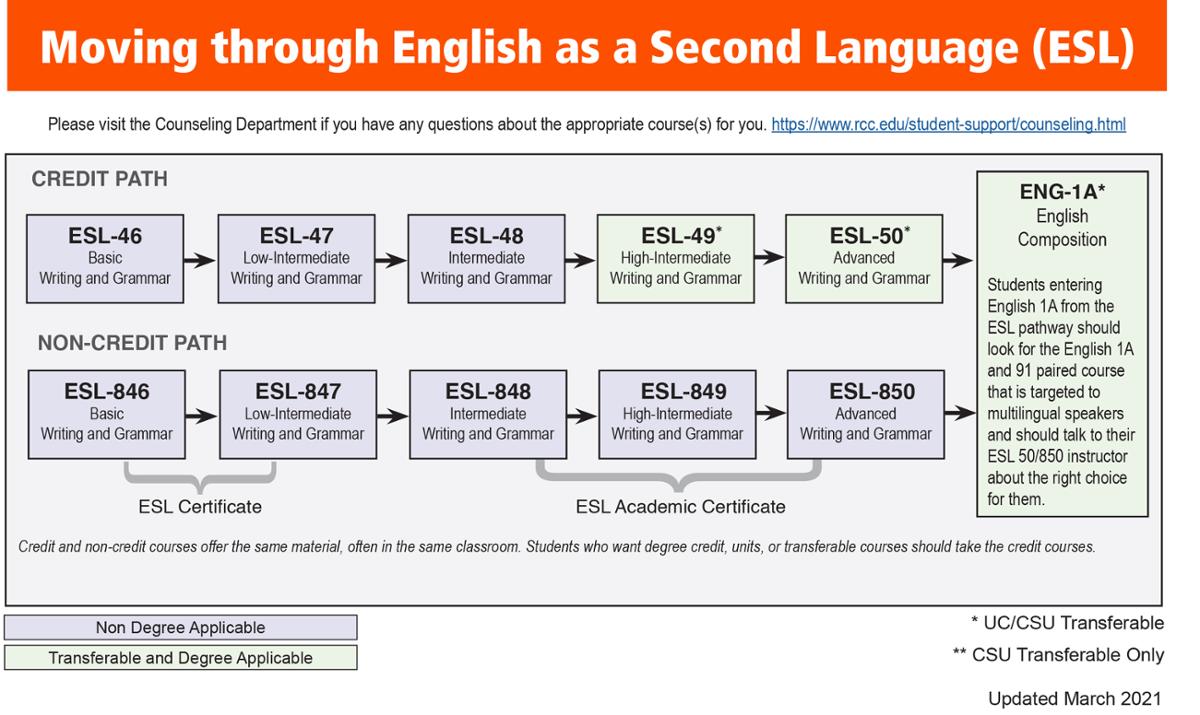English as a Second Language

English as a Second Language
Whether you are an international student, a long-time resident, or a high-school graduate RCC’s ESL program can improve students English language fluency to be successful in their goals:
-
Earning a degree or certificate
-
Taking academic courses for transfer to universities
-
Advancing in a career
-
Improving reading, vocabulary, and writing skills
-
Communicating with confidence
The tools on this page, and guidance from college counselors, can help you select the course that is right for you.
Step 1: Use the RCCD Guided Self Placement Tool to understand which ESL course is right for you.
Step 2: Decide if you want to take credit or noncredit courses depending on your educational goal. Students can learn more about this in “What Course Should I Take?”
Step 3: Apply and Register for courses
What ESL Courses Does RCC Offer?
RCC’s ESL program offers a sequence of academic ESL courses from low-intermediate fluency leading to English 1A. These are our core courses.

Oral Skills Courses: ESL 91, 92, and 93
Reading and Vocabulary Courses: ESL 71, 72, and 73
Special Topics Courses: ESL 90D, ESL 90L and more
| ESL COURSES List | Class Schedule |
What Courses Should I Take?
RCC’s ESL program offers a sequence of academic ESL courses from low-intermediate fluency lead to English 1A. New students need to choose the appropriate course level and decide whether to take the course as credit or noncredit. The RCCD Guided Self Placement Tool can help students decide which course to take.
Most ESL classes are offered as credit or noncredit. Students can choose the best option for their educational goals. These courses are mirrored, meaning that students who take the credit or noncredit courses are in the same classroom, with the same teacher, and have the same educational experience.
Courses that are credit are numbers ESL 46 - ESL 50, and courses that are noncredit are the same number with an “8” added: ESL 846 - ESL 850.
Credit and non-credit courses offer the same material, often in the same classroom and with the same teacher.
| Should Students Take Credit or Noncredit Courses? | |
| Credit | Noncredit |
|---|---|
|
|
| Differences Between Credit and Noncredit Pathway Courses | ||
| Credit | Noncredit | |
|---|---|---|
| Cost | Enrollment fees apply: $46 per unit x 5 units =$230 for residents |
Enrollment fees do NOT apply |
| Out-of-state tuition fees apply to students that are not residents: $265 per unit x 5 units = $1,280 |
Out-of-state tuition fees do NOT apply, including for undocumented students | |
| Units | 5 units | 5 units |
| Financial Aid | Financial aid available | Students must pay for books—no financial aid available |
| Repeatability | Students may repeat if they do not pass the class | Students may take the class again regardless of grade |
| Transferability | ESL 49 and 50 transfer | Not for credit or transfer |
| Certificates | Noncredit certificates available | |